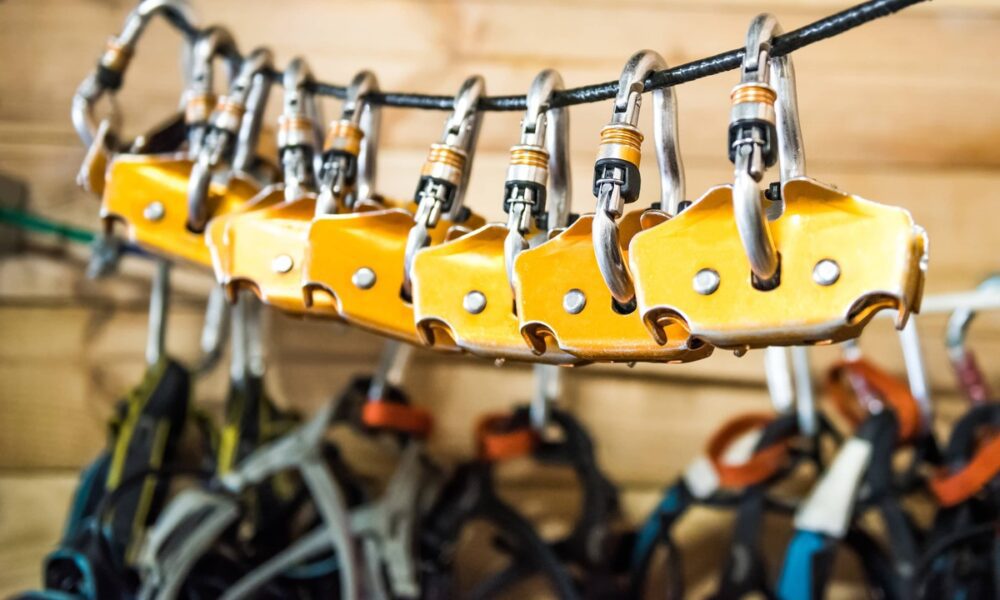How to Use Ratchet Straps

A ratchet strap (also known as a tie down strap or a lashing strap) is used to secure items of cargo during transport. They are made of flexible and durable polyester webbing which are usually water resistant and very difficult to stretch. The ratchet allows to tighten or loosen the straps around the cargo to lock it in place during transport. It uses a mechanism of tensioning the strap which is called a ratchet attached to the end of the strap.
Types of Ratchet Straps
The 2 most common types of ratchet straps are loop straps and two-piece straps.
- Loop straps: these are single pieces of webbing that are looped around the product to secure it by joining two ends together at the tie down fastener to secure the connection and provide tension.
- Two-piece straps: the 2 piece straps are a piece of webbing that are made of 2 pieces which have their own hardware that are fastened together at one end at the fastening point required to protect and connect each other.
There are other types of ratchet straps which can be distinguished based on custom end fitting options of the straps
- Flat Hooks: These are made of steel and are chromate plated to prevent the rusting of steel. They are compatible with flat anchor points like rub rail, stake pockets etc. Flat hooks are compatible with L – tracks if there is a flat – hook receiver. They can easily anchor firmly and securely.
- J Hooks: Also known as Wire Hooks, J hooks are compatible with D rings, O rings and trailer sides. You can install floor plates under the truck bed to provide a variety of j-hook-compatible anchor-point alternatives. Additionally, you can fasten separate D- and O-ring anchor points to your flatbed.
- Chain Hooks: Chain Hooks which are also called Grab Hooks are connected to a chain end fitting to increase ratchet straps WLL. These are compatible with almost all anchor points and are incredibly sturdy. Grab Hooks are typically forged from steel alloy and are chrome plated to resist rust.
Ratchet straps come in different sizes or widths as well
1” Tie downs: are flexible and have a little working load limit but are still considered strong. These are most commonly used for cruisers transport as the webbing avoids harm. They are moreover utilized in gardening, diy applications, moving etc. or securing baggage onto a vehicle. They come with distinctive equipment hooks such as S hooks, wire hooks or snap hooks.
2” Tie downs: are most commonly found on flatbed trucks and trailers. Additionally utilized for vehicle transport. The most prevalent lengths of the 2” ratchet strap are 27′ and 30’ although they are more accessible in much longer lengths. The end hardware will vary on the utilization. There are a few ratchet strap hooks but primary ones are the ratchet strap with level hook and the ratchet strap with wire hook also known as the ratchet strap J hook.
3” and 4” Tie downs: are for heavier items. These are designed especially for flatbed industry and for industrial commercial use. They also include a variety of hardware hooks like Flat hook, wire hook, Delta hook and Chain ends.
What is the need for a Ratchet Strap?
A ratchet strap is used for shipping and transporting cargo as a securing strap that protects and secures products from disturbances. A ratchet strap can be attached to any item size and offers high strength and protection.
While transporting, goods tend to move around the vehicle freely which might damage the goods. A ratchet strap is important to securely mounting goods or furniture on the ceiling of cars or in the back of a van while transporting it. They are commonly used to secure pallets in the back of transport lorries or on cargo ships.
Advantages of Ratchet Straps
Ratchet straps are heavier than other thread fasteners but offer some advantages. For instance, a ratchet strap is incredibly strong and withstand tremendous force and secure large or heavy objects. The “ratcheting” portion of the straps also allows slack in the tie strap to be eliminated. It emphasizes the brace, preventing movement and completey secures the transported goods.
Finally, the ability of ratchet straps to change tension allows for considerable variety and adaptability which allows them to be used the same as hardware to attach different items. Ropes, direct ratchet load straps, long lasting, durable and durable tape and used hardware also ensure long service life and consistently excellent quality.
Step 1 : Release the lever to open ratchets
Use the release lever to lift up the ratchet handle and axle simultaneously to open which is located at the center of the movable top of the ratchet.
Step 2 : Close the ratchet and flip it
Close the ratchet by pulling up on the release catch and flip the ratchet
Step 3 : Pull the strap through open slot
Take the open slot and thread the free end of the strap by bringing the strap under the ratchet and pushing it through the open slot. Wind it around the axle and slip the strap back through the same opening. The strap should face straight and overlap the second half of the strap on the opposite side
Step 4 : Secure the End – Fittings
Take the attached end-fitting on both ends of the strap and place into position
Step 5 : Pull the End of the strap
Pull the free end of the strap until there is no slack between the two ends of the strap
Step 6 : Tighten the Ratchet
Pump the ratchet handle to get rid of remaining slack and tighten the strap, stop ratcheting once it feels secure and be careful not to over-tighten
Step 7 : Close to Lock the Ratchet Handle
Close the ratchet when the strap is taut and lock the strap in place by flipping the ratchet back into closed position and pressing it closed until you hear a click.
Step 8 : Pull and Hold the Release handle
To unbuckle the straps, pull and hold the release handle which will override the ratcheting function and release the lock opening the handle which will allow for easy pulling of strap through axle slot
Step 9 : After usage, inspect, wrap, store
After using a ratcheting strap, wrap it up and tie it with a rubber band. Once it is secure, put the strap and ratchet hardware in a dry case or bag after checking for any damages or tears to the ratchet, end fittings and strap.
There are many companies that make ratchet straps and provide customized ones. One of the best brands that provide quality ratchet straps is Strap Lizard. It solves common issues related to ratchet straps like it’s organization, usage and customization.





